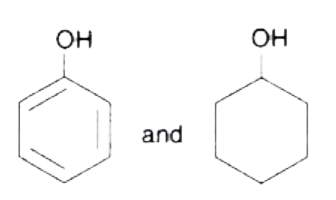Give one good chemical test to distinguish between the following pairs of organic compounds :
Benzaldehyde and acetone.
To distinguish between benzaldehyde and acetone, we can use the Iodoform test. Here’s a step-by-step solution:
Step 1: Understand the Compounds
- Benzaldehyde (C6H5CHO): It is an aromatic aldehyde.
- Acetone (CH3COCH3): It is a ketone and specifically a methyl ketone.
Step 2: Identify the Functional Groups
- Benzaldehyde contains an aldehyde functional group.
- Acetone contains a ketone functional group with a methyl group attached to it.
Step 3: Perform the Iodoform Test
- The Iodoform test is used to identify the presence of methyl ketones or compounds that can be oxidized to methyl ketones.
Step 4: Reaction with Iodine and Sodium Hydroxide
- When acetone is treated with iodine (I2) in the presence of sodium hydroxide (NaOH), it undergoes a reaction to form iodoform (CHI3), which is a yellow precipitate.
- The reaction can be summarized as follows:
CH3COCH3+I2+3NaOH→CHI3+3NaI+2H2O
- In contrast, benzaldehyde does not contain the methyl ketone structure and will not react to give a yellow precipitate.
Step 5: Observe the Results
- If a yellow precipitate forms, the compound is acetone.
- If no precipitate forms, the compound is benzaldehyde.
Conclusion
The Iodoform test effectively distinguishes between benzaldehyde and acetone, as only acetone will yield a positive result (yellow precipitate).
---
- Benzaldehyde (C6H5CHO): It is an aromatic aldehyde.
- Acetone (CH3COCH3): It is a ketone and specifically a methyl ketone.
- Benzaldehyde contains an aldehyde functional group.
- Acetone contains a ketone functional group with a methyl group attached to it.
- The Iodoform test is used to identify the presence of methyl ketones or compounds that can be oxidized to methyl ketones.
- When acetone is treated with iodine (I2) in the presence of sodium hydroxide (NaOH), it undergoes a reaction to form iodoform (CHI3), which is a yellow precipitate.
- The reaction can be summarized as follows:
CH3COCH3+I2+3NaOH→CHI3+3NaI+2H2O
- In contrast, benzaldehyde does not contain the methyl ketone structure and will not react to give a yellow precipitate.
- If a yellow precipitate forms, the compound is acetone.
- If no precipitate forms, the compound is benzaldehyde.
The Iodoform test effectively distinguishes between benzaldehyde and acetone, as only acetone will yield a positive result (yellow precipitate).
Topper's Solved these Questions
Similar Questions
Give chemical test to distinguish between

View SolutionGive a chemical test to distinguish between the following pairs of compounds:

View SolutionGive one good chemical test to distinguish between the following pairs of compounds :
Methanal and ethanal.
View SolutionGive one chemical test to distinguish between the following pairs of compounds :
Acetone and benzaldehyde.
View SolutionGive one good chemical test to distinguish between the following pairs of compounds
Urea and acetamide
View SolutionGive one chemical test to distinguish between the following pairs of compounds :
Acetaldehyde and benzaldehyde
View SolutionGive chemical tests to distinguish between the following pairs of compounds :
Benzaldehyde and benzoic acid.
View SolutionGive one chemical test to distinguish between the following pairs of compounds :
Phenol and benzoic acid.
View SolutionGive one chemical test to distinguish between the following pairs of compounds :
Ethanol and acetic acid
View SolutionGive one chemical test to distinguish between the following pairs of compounds :
Ethanol and 2 propanol.
View Solution
